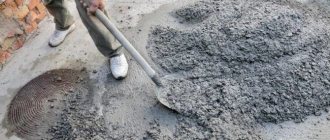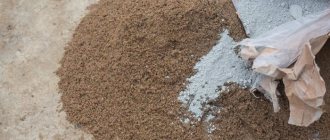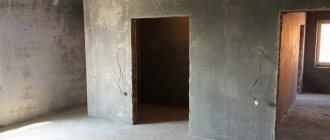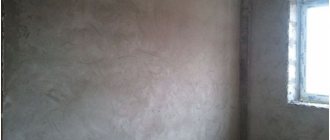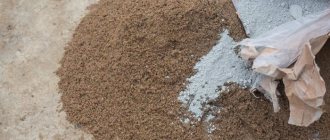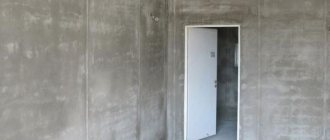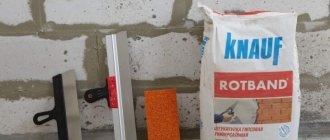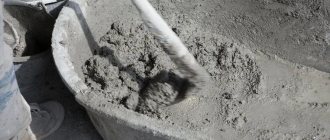Leveling walls with plaster is one of the main stages of pre-finishing work, which affects the quality of repairs, durability and aesthetics of the finish. Here, more often than others, lime mortar is used for plaster - durable, easy to work with, relatively inexpensive, and proven over time.
In the article we will tell you how to make a lime mortar for plaster, we will analyze several recipes for preparing the mixture, how much lime to pour into the mortar for plaster, we will talk about the advantages and disadvantages, and we will make a comparative description of ready-made materials.
Features and composition of lime plaster
The purpose of such mixtures is simple: to level the surface and prepare it for subsequent finishing work. This will help protect the wall from negative influences, and the process of applying a decorative layer will be simplified significantly.
Lime mortar for plaster must be prepared immediately before finishing. There is an option to buy ready-made plaster and dilute it according to the instructions on the package. For example, a good and proven option is cement-lime plaster Knauf UP 210. The proportion of components is indicated.
If you want to save money and make the composition yourself, then you need to know the composition. The solution consists of the following components:
- Lime;
- Sand;
- Water.
Added lime to the composition makes the plaster more flexible and protected from cracks. It is easier for beginners to work with; it goes well with wooden surfaces. However, lime plaster is intended for interior work, as it does not withstand moisture.
Cement-lime plaster, technical characteristics:
- The color of the mixture is light gray.
- Consumption is approximately 1.5 kg/m2 with a layer thickness of 1 mm. Consumption depends on the type of surfaces and their curvature. The thickness of the starting plaster layer is not less than 5 mm.
- Water consumption is from 0.17 to 0.2 liters of water per kilogram of mixture.
- For 2–3 hours, the prepared plaster will not lose its suitability. This is a plus for beginners.
- Adhesion to the surface after a day is 0.3 MPa, after a month – 0.5 MPa no less.
- Optimal conditions for application are from 5 to 30 degrees above zero.
- Vapor permeability indicators from 0.1 mg/mchPa.
- The number of freezing and thawing cycles (frost resistance) is 50 cycles.
- Compressive strength 7 MPa.
- Sold in paper bags. Average weight – 25 kg.
The characteristics of the prepared mixture are excellent. That’s why I use it so often when leveling walls.
A few final tips
As you can see, preparing lime mortar is a simple process. However, many, in an effort to save their own time, buy ready-made solutions in construction stores. Naturally, they differ in quality and cost. If you still decide to buy a ready-made solution rather than make it yourself, here are some tips:
- Don't save money. Price and quality are directly related.
- A well-known brand of lime mortar is a guarantee of good quality.
- Make purchases from trusted sellers in large building materials stores or directly from the manufacturer.
- Before purchasing, check the integrity of the packaging. Ingress of moisture and debris is unacceptable.
We hope our advice will help you in your choice and make any repair work in your home simpler, easier and cheaper. Choose wisely and you will always win.
Advantages and disadvantages
List of advantages that the mixture has:
- Versatile, can be applied to concrete, brick, plasterboard and wood.
- It is light in weight and will not load the structure like cement plaster.
- Plastic, easy to work with, long shelf life after mixing.
- It is vapor permeable, moisture passes through the walls, and the optimal microclimate inside is not disturbed.
- Lime mortar has good thermal insulation characteristics.
- If the application technology is followed, there will be no cracks.
- Alkali prevents the development of fungus and mold on the surface.
- Does not burn and does not support combustion.
As for the disadvantages, they are:
- Insufficient strength.
- Before making a lime mortar for plaster, it is important to know the proportions and slak the lime in advance. This is a long process, taking approximately two weeks.
- The material is afraid of moisture.
- It takes quite a long time to dry.
Area of use
Depending on the type and composition of the lime mortar for plaster, it is used for finishing surfaces inside and outside. These are agricultural buildings, industrial buildings, residential and public premises.
However, when working with lime, you need to take into account several nuances:
- A layer of plaster will not work if you plan to fix furniture or household appliances to the wall.
- It is not recommended to use mixtures for rooms with high humidity levels: kitchen, bathroom, basement.
Video description
Watch the video on how to make clay plaster:
Lime-cement mortar
Lime-cement mortar is considered universal for external and internal work.
Where is lime-cement mortar used?
It is used:
- for finishing the facades of private buildings;
- utility buildings;
- production workshops;
- balconies and loggias;
- residential premises.
Limitations for the use of lime-cement complex:
- In climate zones with high humidity, use on building facades is not recommended.
- In damp basements.
- In wet production workshops.
- For any external and internal work, if the humidity level exceeds 65%.
The material is intended for rough finishing of walls. It is durable and has a fairly long service life.
Proportions and preparation of cement-lime mixture
First, choose a brand of cement. The M400 grade is suitable for processing internal surfaces, and the M500 is suitable for external work. It is better not to take cement that has expired, because the consumption will have to increase, and the quality will be low. For example, brand M500, after a month of storage becomes brand M450, and after six months it loses about a quarter of its astringent and fastening properties.
The proportions of the solution for plastering walls made of cement and sand are shown in the table.
| Cement brand | Cement | Sand | Lime |
| M400 | 1 bucket | 4 buckets | 0.2 buckets |
| M500 | 1 bucket | 5 buckets | 0.2 buckets |
Proportions for lime-cement plaster Source multiurok.ru
Types of mixtures, depending on additional components
Lime mortar can be strengthened and given better characteristics by adding sand, cement, gypsum and clay to the composition. Each of the plaster options has its own characteristics.
Lime-sand mixture
Typically used for treating garages and utility rooms where appearance is not so important. Inexpensive analogue of cement mixture. Lime-sand plaster can be prepared in different proportions:
- To make a soil solution, use a 1:2 ratio (lime/sand).
- To make the spray mixture, the proportion is the same - 1:2.
- The limestone-sand covering layer is made with a ratio of 1:5.
Preparation features: the components are mixed dry, after which water is gradually added to them. Ideally, use clean river sand. It is sifted through a sieve to avoid lumps and impurities. Hardening occurs slowly, so the layer can be covered with plastic wrap and work continued the next day. Properties will not be lost.
Limestone-cement mixture
The advantages are its strength and protection from moisture. Scope of application: facades and indoor spaces. Cement-lime plaster is made according to different proportions, it all depends on the type of solution:
- Spraying is carried out with a solution with proportions of 1: 0.4: 4, where 1 is cement, 0.4 is lime, 4 is sand.
- The primer is mixed in a ratio of 1:1:4.
- For covering, cement-lime plaster has a proportion of 1:1.5:1.5.
To simplify the task, you can buy a ready-made dry mixture. For example, Knauf UP 210 30 kg plaster. With its help you can create a water-repellent layer on any surface. Can be applied manually or mechanically. Color grey. The consumption will be 23.1 kg/m2 with a layer thickness of 15 mm.
Lime-gypsum mixture
The advantage of using gypsum is that it allows you to create a more flexible and smooth structure. It is smooth, durable and dries faster. Ideal for stone and wooden surfaces.
Such decorative lime plaster can be prepared with the following proportions:
- Spraying – 1:0.5:2, where 1 is lime, 0.5 is sand, 2 is gypsum.
- Primer – 1:1:2.
- As a decorative covering layer – 1:1.5:2.
It is more difficult for beginners to work with such plaster, as it dries faster and loses its shelf life. Therefore, the batch is made small. Also, gypsum is afraid of moisture, so it is used for dry rooms.
Lime-clay
Less popular option. The scope of use is limited to finishing mud huts, fireplaces and stoves. After all, the mixture is stable at high temperatures, does not crack or fall off. Options for how much lime to add to the plaster solution:
- To make a primer layer, the proportion is 2:1.5:2, where 2 is lime, 1.5 is clay, 2 is sand.
- Plaster for spraying is prepared in a ratio of 2:1:3.
- The coating has a ratio of 2:1:3.5.
Requirements for clay: medium fat content, no impurities. If you take thin clay, the plaster will not stick to the trowel, so its quantity needs to be increased. If you choose clay that is too oily, you will have to increase the sand content.
How to prepare a solution for ceiling plaster. Selection of material for plaster
Plaster is a thick mixture that is designed for finishing various surfaces. The process of plastering a ceiling involves applying plaster to the ceiling to create a flat, smooth surface. In general, this process can be divided into plastering (primary elimination of unevenness) and putty (finish leveling of the surface). The main requirements for the materials used: good adhesion with different materials used in construction; the ability to form a smooth surface using simple methods; solidity; resistance to external influences.
Plaster building mixtures.
Plasters can be divided into two large groups - cement-based and gypsum-based mixtures. To increase the functional properties and manufacturability, various substances are added to the mixture. Cement mortar is a mixture of cement and sand in a ratio of 1:(3-4). To increase elasticity, a cement-lime mortar is used, when milk of lime (0.7-1 part of slaked lime diluted in water to a liquid state) is added to the mixture of cement and sand. Pure gypsum mortar is usually not used for plastering. Lime-gypsum mortar is widely used. It is a mixture of gypsum and lime mortar in a ratio of 1:(3-4). In turn, lime mortar is prepared in the form of a mixture of slaked lime and sand in a ratio of 1: (4-6).
Self-prepared solutions allow you to plaster the ceiling with your own hands, but cannot provide the desired reliability. Currently, dry construction mixtures are being sold, which significantly increase the reliability and quality of the material. This mixture contains mineral and polymer additives that increase their elasticity and strength. Their basis can be cement and gypsum.
Scheme for the production of lime dry plaster mixture.
For plastering ceilings, dry gypsum-based building mixtures are most often used. However, in rooms with high humidity and other influences of various factors, cement-based mixtures should be used for interior work. Colored building mixtures are produced for decorative plaster. In addition, mixtures differ in the granularity of the additives, which should be taken into account when choosing a composition for plaster (grain size can exceed 2.5 mm) and putty (grain size no more than 0.3 mm). In general, dry building mixtures are divided according to purpose into the following types:
- plaster leveling;
- protective covering;
- putty;
- primer;
- adhesive layer;
- color decoration.
Making your own solution
First you need to slak the lime for the plaster so that it is suitable for work. This requires a metal container, since the reaction is accompanied by a large release of heat and an increase in volume by 3 times. The lime packaging indicates the slaking speed: slow (25 minutes or less), fast (8 to 10 minutes), medium, 15 to 20 minutes. It is better to mix the mixture with a shovel or oar. Slaking is carried out for at least a day, however, ideally use lime that has been standing for a month.
The note ! The sand also needs to be prepared before preparing the plaster: remove impurities, clean it by passing it through a sieve.
Instructions for creating a limestone-sand mortar:
- Sand is mixed with lime paste in the selected proportion. This is done dry and mixed thoroughly.
- After which water is gradually added to the container. There is no need to pour in the entire volume at once; it is poured in in a thin stream, and the solution is constantly stirred.
Now that the preparation is complete, you can begin plastering the surface.
Application instructions
All work is done gradually. You need to create three layers, each of which has its own functional purpose. This is the only way to achieve optimal results.
The technology is as follows:
- Creating the first layer, spraying. Its purpose is to improve the adhesion of the first layer to the wall, as well as to fill all the voids and cracks to avoid the formation of voids. The optimal consistency is creamy, not too thick. The plaster is spread over the entire wall with a trowel. There is no need to level the layer. This process can be mechanized with a special spraying device. The layer thickness is small.
- The second layer is soil. He's the main one. Its thickness is up to 50 mm. The solution is doughy, thicker than for spraying. Application occurs using trowels or trowels. Excess solution will be removed by the rule. They also check the evenness of the surface.
- The final layer is the covering. It eliminates all defects, chips and creates a smoother and more uniform surface. The thickness of the mixture resembles a spray solution. Application occurs on a damp wall, the layer thickness is several millimeters. At the end, you need to treat the layer with a float to remove defects and make the wall smoother.
This was a technical process of applying limestone plaster. If you practice, you can do work inside or outside quickly and efficiently. This mixture has many advantages, including versatility, vapor permeability, plasticity and ease of application. And if everything is done correctly, the finish will last for decades.
How to apply?
The first stage of applying lime plaster is spraying. Some people skip it, but it’s better not to do this, because the spray allows you to ensure a good connection of the surface with the plaster mixture. It is better to use a solution that resembles jelly in consistency: it should contain a little more water than usual.
Place the mixture on a trowel and begin dripping it onto the surface. Then the material will need to be stretched a little, but you should not make the coating perfectly smooth. Wait a day. After this, you can apply another layer.
You can make the main layer quite thick (about 50 mm). The plaster must be applied with a spatula and stretched using a trowel. The layer must correspond to the level at which the beacons are located. Make movements from top to bottom. Having finished processing one area of the surface, remove excess plaster using the rule.
Then you need to cover it. For this, a more liquid material is used (as for spraying). The thickness of such coating should not exceed 3 mm. After application, you will need to level it and wait two to three hours. Then you should treat the entire surface using a grater with coarse sandpaper. After this, you will need to use fine-grained sandpaper.
See below for more details.
